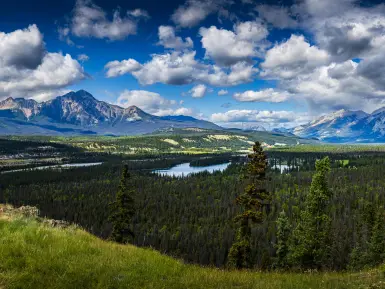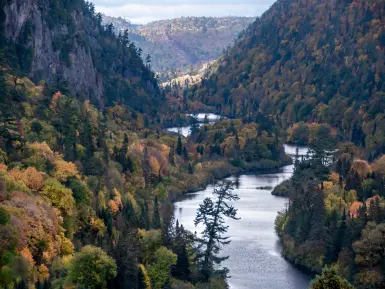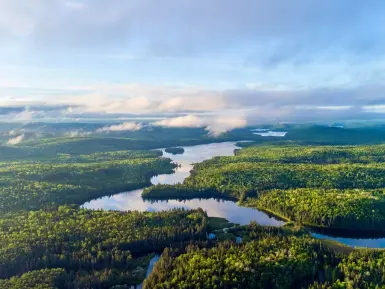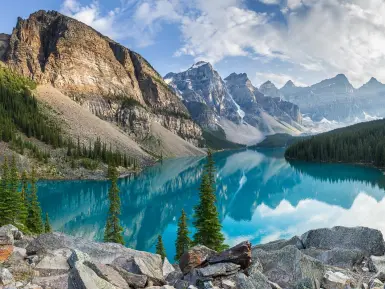If you’re interested in nature travel, there is no better place to visit than Canada as it is home to some of the most spectacular animals in the world and stunning landscapes like the Rockies and the Bay of Fundy. Whether you want to watch Orca and Humpback Whales in Canada’s seas, grizzly bears queuing up at rivers to catch salmon or an eagle circling around snowy mountain peaks, there is an abundance of wildlife you can see on one of our Canadian holidays.
Our wildlife holidays in Canada mean you can view these animals in their natural habitats, as you can stay at eco-resorts in the Great Bear Rainforest and floating resorts in British Columbia that let you enjoy close encounters with wildlife in unspoilt wilderness.
If you are heading on a wildlife holiday to Canada, you will want to remember your trip by taking lots of photographs of the places you visit and the animals you see. It can be extremely difficult to take photographs of animals in the wild, but in this guide, we have spoken to some award-winning nature photographers who have shared their top tips as well as information about the equipment you should take on your holiday.
Tips for photographing wildlife in Canada
• Choose a specific area of Canada to visit and explore
• Don’t disturb the wildlife and keep a safe distance
• Use a tripod
• Get up early or head out late in the day
• Use a telephoto lens
• Research the animal you want to photograph
• Other wildlife photography tips
Choose a specific area of Canada to visit and explore

Canada is the second-largest country in the world, and it has the longest coastline in the world, with more than 240,000 km of shoreline. Even though you can book car hire in Vancouver and in other major cities across Canada, the enormity of the country makes it difficult to see everything in just a few weeks.
That’s why it is best to choose an area of Canada that you want to visit, whether that is the west coast or the east coast.
This is something that Robert Berdan, the owner of the Canadian Nature Photographer site, also recommends doing. He told us about this and some of his favourite places to photograph nature.
“Canada is one of the best places in the world to photograph wildlife. There are many wild locations across our large nation. The size of Canada is such that you really need to choose a specific area to visit and explore. My top locations for wildlife photography are The Great Bear Rainforest in British Columbia, but you will need to hire a boat to take you there. You may see killer whales, sea lions, invertebrates, grizzly bears, wolves and the white Spirit bear.
“Another one of my favourite locations is Yellowknife and north on the tundra where you can view the aurora borealis, caribou, wolves and grizzly bears. The Rocky Mountain regions in Alberta and British Columbia are other good locations to see wildlife throughout the year. Newfoundland is one of my favourite locations to view sea birds such as gannets and puffins. You can see and photograph wildlife all across Canada, but you will need to get outside the cities and visit the countryside, national and provincial parks.
“My favourite places to take photos in Canada are the West Coast, the Rocky Mountains, Tundra, and the East coast.”
READ MORE: Where are the best places to see wildlife in Canada?
Don’t disturb the wildlife and keep a safe distance

The welfare of the wildlife you are photographing should always come first and you should always maintain a safe distance between yourself and the animal you are photographing.
By keeping a safe distance, you are allowing the animal to be in their comfort zone and are much more likely to capture their natural behaviour. You also need to take into account your own safety as an animal that feels threatened can attack.
Many experts say you should keep a distance of around 100 yards away from wildlife when you are photographing them to ensure the wellbeing of the animal and your own safety.
Jason Leo Bantle, the award-winning photographer behind the All in the Wild Photography site, said: “The most important tip for photographing nature is to ensure an animal’s well-being. Long camera lenses allow you to take great images while respecting the space of the animal.
“If you want to photograph a specific animal, learn its habits and plan your trip accordingly; for example, bears hibernate during the winter. But above all, respect our wilderness and its inhabitants. Help to preserve it as a gift to the world.”
Catherine Babault, who runs her own photography site, also says it is important to respect the wildlife you are photographing: “My main tip is to respect wildlife and practice ethical photography: keep a safe distance from wildlife, avoid disturbing them in their routine and do not attract them with food. Let’s keep them wild!”
Use a tripod
One of the best things you can do to improve your photography is to mount your camera onto a tripod as this will help to reduce camera shake, which is what causes photographs to become blurry.
This is something that highly acclaimed photographer Jim Brompton talked to us about and recommended budding photographers to use. As Jim now specialises in landscape photography, he insists that his five tripods are some of the most essential pieces of photography equipment he owns. Jim has even developed a technique for photographing waves that allows him to produce stunning images that almost bare more resemblance to a painting than a photograph.
He said: “Use a tripod to help stabilize the camera and produce sharper images.”
Some photographers take this a step further and use a shutter release cable as this eliminates the need to touch the camera while snapping shots and thus removes almost all potential for camera shake.
Get up early or head out late in the day

Wildlife is most active early in the morning or late in the day/evening and therefore if you head out during these times you will increase your chances of seeing more wildlife.
Photographing nature can take a lot of patience, but by rising early in the morning it will give you the best chance to catch the animals that are active in the daylight. During the summer months, many animals prefer to be on the move when it is cooler, so waking up early and being ready to take photographs of the wildlife you come across is certainly something you should do.
Robert Berdan, the Canadian Nature photographer, also revealed what he thinks is the best time of the year to travel to Canada: “You can see wildlife all year long, but fall, winter and spring are the best times.”
Use a telephoto lens
As we’ve already mentioned, staying a safe distance from any wildlife you are photographing is important and with a telephoto lens, you can do this and still get a great photograph.
Telephoto lenses bring the subject of your photo closer and with this type of lens, you will feel like you are just a few steps away from the wildlife when in reality there is a fair bit of distance between you. When shooting with telephotos it can also be easier to produce shots where the subject is separated from the background as the zone of sharpness is more restricted.
This type of lens is one that Robert Berdan recommends taking with you on a holiday to Canada: “Whatever type of camera you bring, be sure to have a telephoto lens with at least 200 mm and if you have a camera with interchangeable lenses have the telephoto lens on when driving.”
Research the animal you want to photograph

No matter whether it is a grizzly bear, wolf or moose, if there is a particular animal you really want to photograph when you are in Canada then before you head on your trip you should research it and get to know the animals you want to photograph.
Find out where these animals live, what time of the year they are present there and the food they eat as this will not only help you find the wildlife, but it can also help you to get better photographs.
Other wildlife photography tips
Robert Berdan also shared some extra tips for anyone who is photographing nature in Canada, and you can see these below:
• Examine the photography of local photographers and contact them to see if they offer tours or may point you to some hotspots.
• If you are looking for birds, travel to marshes, lakes, and coastal areas.
• Avoid busy locations with lots of tourists if you can.
• If you are travelling by car, stop frequently, and if you have binoculars, keep them close by to search for wildlife.
READ MORE: Searching for the Big Five in Northern BC’s wilderness
The best equipment to take on a photography holiday in Canada

If you are visiting Canada and want to take photographs of the incredible wildlife that call it home, then there are a few essentials items of equipment that you should be packing. It doesn’t matter whether you are a budding photographer or have been a wildlife photographer for years, there are a few things that can prove useful when you are visiting Canada.
Jason Leo Bantle from All in the Wild Photography told us about some of the essential items you need to pack: “For your own safety, bring an emergency beacon, back-country emergency kit, and bear spray. You should also bring binoculars, a sturdy tripod, and multiple batteries (store them in your inner clothing to keep them warm in the winter). Dress in layers: Canadian weather is often unpredictable and can change quickly. If you’re visiting in the winter, make sure your gear is rated for -40° Celsius. Do your research to ensure your safety.”
Hiking boots are another essential item you should pack and Catherine Babault told us why they are so important: “I recommend a good pair of hiking shoes to photograph wildlife in Canada as you may have to hike on muddy trails or a rugged coastline.”
Depending on what time of the year you are visiting Canada will depend on whether you pack certain items or not and this is especially true when it comes to clothing. Robert Berdan says packing the correct clothing for the time of the year is vital: “Dress for the weather you expect to encounter and bring lots of memory cards to store images and a battery charger.”
You should also ensure you have packed extra batteries as it is always a good idea to have a backup in case something happens to the one that you have in your camera.
Equipment to pack for a holiday to Canada
• Emergency beacon
• Back-country emergency kit
• Bear spray
• Binoculars
• A tripod
• Multiple camera batteries
• Hiking boots
• Appropriate clothing for the time of year you are visiting
• Memory cards
• Laptop
These are just some tips you can use if you are looking to photograph nature on your next holiday to Canada as well as a guide to some of the equipment you can take with you. If you have been inspired and want to book a holiday to Canada, our experts can tailor-make the perfect adventure for you. For more articles like this, check out the blog section of our website.
Latest Articles

Canada Advocate Q&A: Trish & Cathie's Race Across The World Adventure


01/07/2025
Join us this Canada Day as we celebrate the breathtaking beauty of Canada with Trish & Cathie, the incredible winners of Race Across the World series 3! Discover Canada through the inspiring lens of two adventurers who truly fell in love with its majestic landscapes and vibrant culture.

Sault Ste. Marie Travel Guide: Undiscovered Canada


30/06/2025
Sault Ste. Marie in Canada is one of Ontario’s premier adventure towns, known for its rugged lakes, mountains, and world-class outdoor activities.

Algonquin Park Travel Guide: Iconic Canada


25/06/2025
Algonquin Provincial Park is one of Canada’s most spectacular wilderness regions. The park, which is Ontario’s oldest and largest provincial park, is filled with rocky ridges, fragrant maples and thousands of lakes.

Moraine Lake Travel Guide: Iconic Canada


04/06/2025
Surrounded by the Valley of the Ten Peaks, Moraine Lake feels like something straight out of a dream that only Mother Nature could shape.











